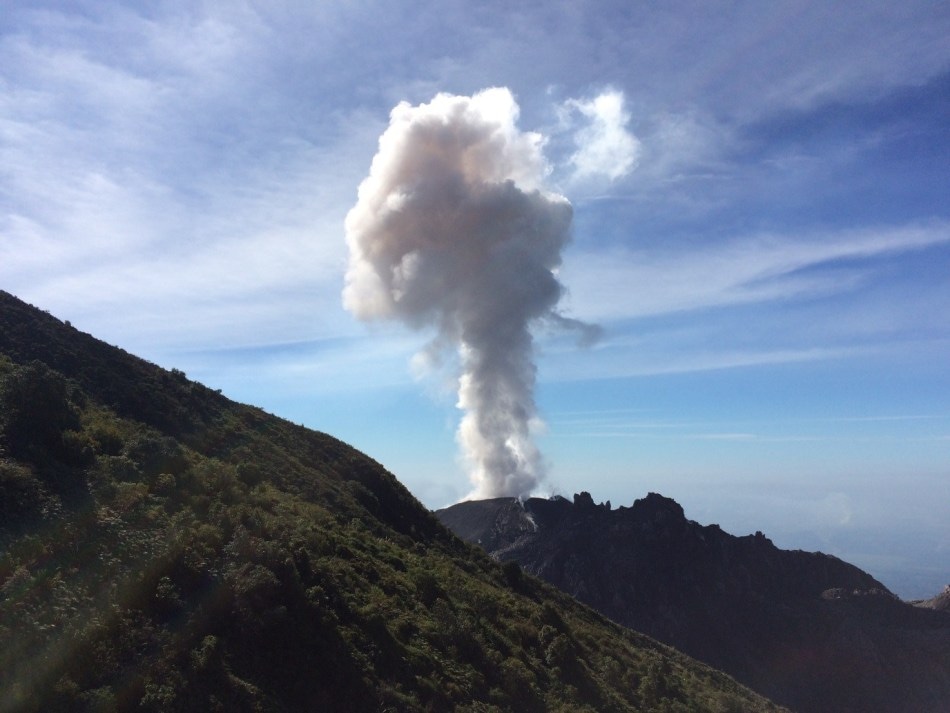Oct 25 2018
Volcanologists based in Manchester have come up with a new technique and camera that may aid in reducing the health risks, dangers, and travel effects of ash plumes at the time of volcanic eruptions.
 In January 2018 the team visited Santiaguito Dome Complex, located in the old eruption scar of Santa Maria volcano in Guatemala and measured a series of explosions. (Image credit: Benjamin Esse, The University of Manchester)
In January 2018 the team visited Santiaguito Dome Complex, located in the old eruption scar of Santa Maria volcano in Guatemala and measured a series of explosions. (Image credit: Benjamin Esse, The University of Manchester)
At times, ash is considered a secondary danger in volcanoes as opposed to more visual hazards, for example, pyroclastic flows and lava. Yet, ash can have a considerable impact on both infrastructure and human lives, for instance, the Icelandic volcano, Eyjafjallajökull, which erupted in 2010 ceased the international aviation across Europe.
The study, which has been reported in Scientific Reports, employs a novel kind of camera. This camera was developed at The University of Manchester to determine the speed and flow of ash emerging from a volcanic plume.
The team measured how ash particles are able to interact with sunlight and, particularly, how they change the sunlight polarization, in a way similar to how polarized sunglasses operate. This has been made possible with the development of the novel “AshCam” - the first-of-its-kind camera in the world.
Heavy ash fall during a volcanic eruption can cause buildings to collapse, possibly injuring or even killing the occupants inside. In addition to this, exposure to ash can also cause irritation to the eyes, nose, and throat, and also aggravate pre-existing health conditions, for example, asthma.
Furthermore, ash also poses a major risk to other critical human infrastructures, such as water, electrical, and transportation networks, particularly air travel.
Professor Mike Burton, Chair in Volcanology at The University of Manchester, stated: “Volcanic ash is a primary product of an explosive volcanic eruption which generally poses a threat to human health and infrastructure. The Icelandic eruption in 2010 highlighted to the whole world that ash-rich volcanic eruptions can have a major impact on the global economy through airspace closures designed to minimize the risk of jet engine failure due to ash clogging.”
The research team visited Santiaguito Lava Dome, part of Santa Maria volcano in Guatemala, and used the camera to determine a series of explosions. Every day, Santiaguito produced several of these explosions, about one every two hours, which made it the perfect place to test out novel methods, equipment, and study models.
Models of ash dispersion are key to forecasting the concentrations of ash during an eruption, which ultimately determine which airspace is closed. Our research helps to measure the dynamics of ash fallout during an eruption. This gives us new insights into volcanic ash dynamics, providing an important step towards improved models of ash dispersion.
Professor Mike Burton
In earlier studies, ground-based UV cameras were used to observe volcanic ash, or black carbon particles in ship emissions were measured. Yet, these techniques failed to differentiate ash from other particles in the ash plume, which made it difficult to determine the ash flow. This is where the new camera “AshCam” stands out. It is made up of commercial cameras that are already commercially available on the market and have been adapted with unique filters that are capable of identifying ash more easily with the help of sunlight.
Benjamin Esse, a PhD Researcher from Manchester’s School of Earth and Environmental Sciences, explains: “AshCam is small, lightweight and relatively cheap, making it ideal for use in volcanic environments where larger, more expensive equipment is unable to be deployed.
“This is an exciting development as it offers volcanologists a tool that allows them to easily measure the dynamics of ash plumes using only sunlight. The results from these measurements can be used to inform ash dispersal models, potentially improving their accuracy and effectiveness in mitigating the risks posed by ash plumes.”
An example of footage from AshCam.